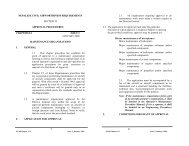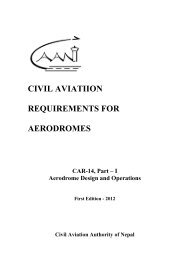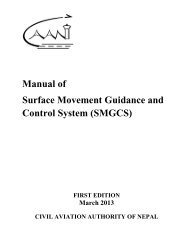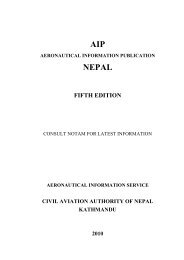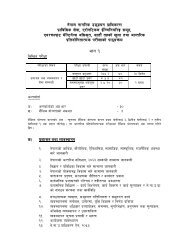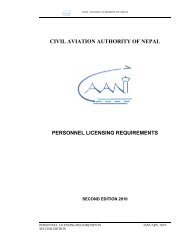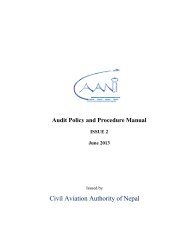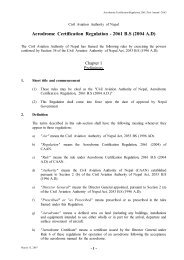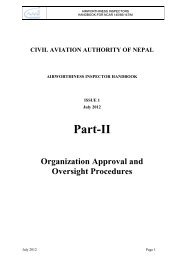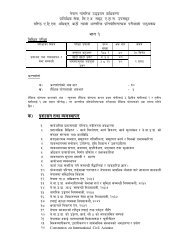Manual of Standards for Licensing/Rating of ATC Personnel
Manual of Standards for Licensing/Rating of ATC Personnel
Manual of Standards for Licensing/Rating of ATC Personnel
Create successful ePaper yourself
Turn your PDF publications into a flip-book with our unique Google optimized e-Paper software.
<strong>Manual</strong> <strong>of</strong> <strong>Standards</strong> <strong>for</strong><strong>Licensing</strong>/ <strong>Rating</strong> <strong>of</strong>Air Traffic Control <strong>Personnel</strong>Civil Aviation Authority <strong>of</strong> NepalFirst Edition – April 2013
Record <strong>of</strong> amendments and corrigendaNoDate <strong>of</strong>IssueAmendmentsDateEnteredEnteredbyNoDate <strong>of</strong>IssueCorrigendaDateEnteredEnteredbyi
FOREWORDThe Air Navigation Services Safety <strong>Standards</strong> Department (ANSSSD) <strong>of</strong> the Civil Aviation Authority <strong>of</strong> Nepaladministers the licensing and rating <strong>of</strong> Air Traffic Controllers.The <strong>Manual</strong> <strong>of</strong> <strong>Standards</strong> – <strong>Licensing</strong>/ <strong>Rating</strong> <strong>of</strong> Air Traffic Control <strong>Personnel</strong> is enacted by Civil AviationAuthority <strong>of</strong> Nepal pursuant to Rule – 82, schedule – 3 <strong>of</strong> Civil Aviation Regulation – 2058 ( 2002 ) andpublished by the ANSSSD. This <strong>Manual</strong> spells out the standards to be met <strong>for</strong> issuing Air Traffic ControlLicenses and associated ratings endorsements <strong>for</strong> Air Traffic Controllers.This is a controlled document and is subject to periodic review. Air navigation Services Safety standardsDepartment will maintain this document as complete, accurate and up-dated as possible. Comments andrecommendations <strong>for</strong> revision/amendment action to this publication should be <strong>for</strong>warded to the Director <strong>of</strong> ANSSafety <strong>Standards</strong> Department.------------------------Tri Ratna ManandharDirector Generalii
TABLE OF CONTENTSAmendment RecordsForewordTable <strong>of</strong> contentsiiiiiiDefinitions 1Abbreviations 3Chapter 1 – INTRODUCTION 4Section 1.1 – General Provisions 4Section 1.2 – General rules concerning licences 4Chapter 2 – AIR TRAFFIC CONTROLLER LICENCE/ RATINGS 6Section 2.1 – <strong>ATC</strong> Licence 6Section 2.2 – <strong>ATC</strong> <strong>Rating</strong>s 7Chapter 3 – EXPERIENCE AND QUALIFICATION OF ON-THE-JOB TRAININGINSTRUCTORS AND DESIGNATED CHECK <strong>ATC</strong>O 11Section 3.1 – On-the-job training instructors and Designated Check <strong>ATC</strong>O 11Chapter 4 – <strong>ATC</strong> MEDICAL ASSESSMENT 13Section 4.1 – Class 3 Medical Assessment 13APPENDICESAPPENDIX A –APPENDIX B –APPENDIX C –APPENDIX D -APPENDIX E –SYLLABUS FOR LICENCING/ RATING EXAMINATION<strong>ATC</strong> RATING ASSESSMENT FORMREQUIREMENTS FOR PROFICIENCY IN LANGUAGESUSED FOR RADIOTELEPHONY COMMUNICATIONSMEDICAL FORMS FOR <strong>ATC</strong>DECREASE IN MEDICAL FITNESSiii
MOS-<strong>Licensing</strong>/ <strong>Rating</strong> <strong>of</strong> <strong>ATC</strong> <strong>Personnel</strong>DefinitionsDEFINITIONSAccredited medical conclusion. The conclusion reached by one or more medical experts acceptable to the<strong>Licensing</strong> Authority <strong>for</strong> the purposes <strong>of</strong> the case concerned, in consultation with flight operations or other expertsas necessary.Aero Medical Assessor. A physician qualified and experienced in the practice <strong>of</strong> aviation medicine whoevaluates medical reports submitted to the <strong>Licensing</strong> Authority by designated medical examiners.Aero Medical Examiner. A physician with training in aviation medicine and practical knowledge andexperience <strong>of</strong> the aviation environment, who is designated by the <strong>Licensing</strong> Authority to conduct medicalexaminations <strong>of</strong> fitness <strong>of</strong> applicants <strong>for</strong> licences or ratings <strong>for</strong> which medical requirements are prescribed.AIP. A publication issued by or with the authority <strong>of</strong> a state and containing aeronautical in<strong>for</strong>mation <strong>of</strong> a lastingcharacter essential to air navigation.Aerodrome Control Service. Air Traffic Control Service <strong>for</strong> aerodrome traffic.Air Traffic. All aircraft in flight or operating on the maneuvering area <strong>of</strong> an aerodrome.Air Traffic Control Service. A service provided <strong>for</strong> the purpose <strong>of</strong>:a) preventing collisions:i) between aircraft, andii) on the maneuvering area between aircraft and obstructions; andb) expediting and maintaining an orderly flow <strong>of</strong> air traffic.Air Traffic Service. A generic term meaning variously flight in<strong>for</strong>mation service, alerting service, air trafficadvisory service, air traffic control service (area control service, approach control service or aerodrome controlservice).Approach Control Service. Air Traffic Control Service <strong>for</strong> arriving or departing controlled flights.Civil Aviation Medical Board (CAMB). It is a board comprising <strong>of</strong> designated AMEs and CAAN <strong>of</strong>ficials torecommend to Director General (DG) <strong>of</strong> CAAN as to the action to be taken in case <strong>of</strong> the flight crew and airtraffic controller with suspicious or overt medical condition and in other medical related matters.Competency. A combination <strong>of</strong> skills, knowledge and attitudes required to per<strong>for</strong>m atask to the prescribed standard.Decrease in Medical Fitness. It is a state or period when there is diminished medical fitness that may beattributable to illness , injuries, drugs or physical, Physiological or mental stresses or finding outside theprescribed normal ranges , which lasts usually <strong>for</strong> certain period <strong>of</strong> time and temporary nature.Flight In<strong>for</strong>mation Service. A service provided <strong>for</strong> the purpose <strong>of</strong> giving advice and in<strong>for</strong>mation useful <strong>for</strong> thesafe and efficient conduct <strong>of</strong> flights.Human Per<strong>for</strong>mance. Human capabilities and limitations which have an impact on the safety and efficiency <strong>of</strong>aeronautical operationsRated Air Traffic Controller. An Air Traffic Controller holding a licence and valid rating appropriate to theprivileges to be exercised.<strong>Rating</strong>. An authorization entered on or associated with a licence and <strong>for</strong>ming part there<strong>of</strong>, stating specialconditions, privileges or limitations pertaining to such license.Civil Aviation Authority <strong>of</strong> Nepal First Edition – April 20131
MOS-<strong>Licensing</strong>/ <strong>Rating</strong> <strong>of</strong> <strong>ATC</strong> <strong>Personnel</strong>DefinitionsDesignated Check Air Traffic Controller ( DC<strong>ATC</strong>O ). An <strong>ATC</strong>O duly designated by the licensing authority<strong>for</strong> the assessment <strong>of</strong> <strong>ATC</strong>O s <strong>for</strong> the purpose <strong>of</strong> issue, renewal and revalidation <strong>of</strong> <strong>ATC</strong> licence or rating.Medical Assessment. It means the evidence issued by licencing authority that the holder meets specificrequirements <strong>of</strong> medical fitness. It is issued following an evaluation by the licensing authority <strong>of</strong> the reportssubmitted by the authorized medical examiners who conducted the examination <strong>of</strong> the applicant <strong>for</strong> the licence.Medical Assessor. A physician appointed by the licensing authority qualified and experienced in the practice <strong>of</strong>aviation medicine and competent in evaluating and assessing medical condition <strong>of</strong> flight.note 1. medical assessors evaluate medical reports submitted to the licensing authority by medical examiners.note 2. medical assessors are expected to maintain the currency <strong>of</strong> their pr<strong>of</strong>essional knowledge.OJT . A system <strong>of</strong> on the job training conducted by an approved person in an approved organization.OJTI . An <strong>ATC</strong>O, with an OJTI endorsement on <strong>ATC</strong> license authorized to supervise and conduct on the jobtraining <strong>of</strong> <strong>ATC</strong>Os .Psychoactive substances. Alcohol, opioids, cannabinoids, sedatives and hypnotics, cocaine, other psychostimulants, hallucinogens, and volatile solvents, whereas c<strong>of</strong>fee and tobacco are excluded.Civil Aviation Authority <strong>of</strong> Nepal First Edition – April 20132
MOS-<strong>Licensing</strong>/ <strong>Rating</strong> <strong>of</strong> <strong>ATC</strong> <strong>Personnel</strong>AbbreviationsAbbreviationsAIPAMEANSPANSSSD<strong>ATC</strong><strong>ATC</strong>OATSCAANCAMBCARDC<strong>ATC</strong>OICAOOJTOJTIPELRAeronautical In<strong>for</strong>mation publicationAero Medical ExaminerAir Navigation Service ProviderAir Navigation Services Safety <strong>Standards</strong> DepartmentAir Traffic ControlAir Traffic Control OfficerAir Traffic ServicesCivil Aviation Authority <strong>of</strong> NepalCivil Aviation Medical BoardCivil Aviation RequirementsDesignated Check Air Traffic ControllerInternational Civil Aviation OrganisationOn-The -Job TrainingOn-The-Job Training Instructor<strong>Personnel</strong> <strong>Licensing</strong> RequirementsCivil Aviation Authority <strong>of</strong> Nepal First Edition – April 20133
MOS-<strong>Licensing</strong>/ <strong>Rating</strong> <strong>of</strong> <strong>ATC</strong> <strong>Personnel</strong>Chapter 1 - IntroductionCHAPTER - 11. INTRODUCTION1.1. General Provisions1.1.1. This <strong>Manual</strong> <strong>of</strong> <strong>Standards</strong> – <strong>Licensing</strong>/ <strong>Rating</strong> <strong>of</strong> Air Traffic Control <strong>Personnel</strong> contains the standards,requirements and procedures pertaining to the licensing and rating requirements <strong>of</strong> air traffic controlpersonnel. In this <strong>Manual</strong>, the term service provider refers to the air navigation service provider (ANSP).1.1.2. This <strong>Manual</strong> is mainly based on compliance with ICAO Annex 1 – and PELR.1.1.3. The service provider shall adhere to the provisions <strong>of</strong> this <strong>Manual</strong>.1.1.4. Where there is a difference between a standard in this <strong>Manual</strong> and that <strong>of</strong> ICAO Annex 1, the standard inthis <strong>Manual</strong> shall prevail.1.1.5. When the service provider is not able to comply with any standards specified or referenced in this <strong>Manual</strong>,the service provider shall apply to DGCA <strong>for</strong> exemption or deviation from the relevant standards.Applications shall be supported in writing with the reasons <strong>for</strong> such exemption or deviation including anysafety assessment <strong>of</strong> other studies undertaken.1.1.6. Any exemption or deviation granted to the service provider shall also be recorded in the appropriate serviceprovider’s operations manual. These manuals shall also contain the details <strong>of</strong> the exemption or deviation,such as the reason that the exemption or deviation was requested and any resultant limitations or conditionsimposed.1.2. General rules concerning licenses1.2.1. Air traffic controller license1.2.1.1. An air traffic controller license shall be issued in accordance with the requirements <strong>of</strong> PELR and this<strong>Manual</strong> <strong>of</strong> <strong>Standards</strong> – <strong>Licensing</strong> <strong>of</strong> <strong>ATC</strong> <strong>Personnel</strong>.1.2.1.2. All rated <strong>ATC</strong>Os shall be in possession <strong>of</strong> a valid air traffic controller license be<strong>for</strong>e they can provideany air traffic service. Unlicensed <strong>ATC</strong>Os shall work only under the supervision <strong>of</strong> OJTI/ rated <strong>ATC</strong>O.1.2.1.3. <strong>ATC</strong> license shall not be issued unless the applicant fulfills the requirements mentioned in para 1.2.2,1.2.8 and 2.1.11.2.2. Medical fitness1.2.2.1. Unlicensed <strong>ATC</strong>Os shall not be permitted to receive instruction in an operational environment unlesss/he holds a current Class 3 Medical Assessment.1.2.2.2. The applicant <strong>for</strong> an air traffic controller license shall hold a Class 3 Medical Assessment issued inaccordance with the provisions contained in Section 4.1 <strong>of</strong> this manual.1.2.3. Privileges <strong>of</strong> the holder <strong>of</strong> a license1.2.3.1. An air traffic control license authorizes the holder to exercise the privileges <strong>of</strong> any current air trafficcontroller ratings and validations held.1.2.3.2. The air traffic controller license shall be retained by the person to whom it has been issued and beavailable <strong>for</strong> presentation on demand whenever the privileges <strong>of</strong> the license are being exercised.Civil Aviation Authority <strong>of</strong> Nepal First Edition – April 20134
MOS-<strong>Licensing</strong>/ <strong>Rating</strong> <strong>of</strong> <strong>ATC</strong> <strong>Personnel</strong>Chapter 1 - Introduction1.2.4. Roles and responsibilities1.2.4.1. An air traffic controller license holder who provides an air traffic control service shall be responsible <strong>for</strong>ensuring s/he;a. is competent to provide the air traffic control services <strong>for</strong> which he/she holds valid rating(s);b. complies with the requirements <strong>for</strong> maintaining currency;c. is not fatigued to an extent that may endanger the safety <strong>of</strong> aircraft to which he/she is providingan air traffic control service;d. complies with any conditions associated with the medical certificate;e. signs his/her license in ink with his/her normal signature.1.2.5. Validity <strong>of</strong> license1.2.5.1. The validity <strong>of</strong> the air traffic controller license shall coincide with the validity <strong>of</strong> the medicalcertification, unless otherwise stated.1.2.5.2. An air traffic controller shall not be authorised to exercise the privileges <strong>of</strong> any rating if the period <strong>of</strong>validity <strong>of</strong> his license has expired.1.2.5.3. An air traffic controller shall not be authorised to exercise the privileges <strong>of</strong> any rating unless he maintainscompetency and meets the requirements <strong>for</strong> recent experience as stated in paragraph 2.2.4.1.2.6. Decrease in medical fitness1.2.6.1. The holders <strong>of</strong> an air traffic controller license shall not exercise the privileges <strong>of</strong> their licenses and relatedratings at any time when they are aware <strong>of</strong> any decrease in their medical fitness which might render themunable to safely and properly exercise these privileges.1.2.7. Use <strong>of</strong> psychoactive substances1.2.7.1. The holders <strong>of</strong> an air traffic controller licence shall not exercise the privileges <strong>of</strong> their licenses and relatedratings while under the influence <strong>of</strong> any psychoactive substance which might render them unable tosafely and properly exercise these privileges.1.2.7.2. The holders <strong>of</strong> an air traffic controller license shall not at any time engage in a problematic use <strong>of</strong>substances.1.2.8. Language pr<strong>of</strong>iciency1.2.8.1. Air traffic controllers shall demonstrate the ability to speak and understand the language used <strong>for</strong>radiotelephony communications to the level specified in the language pr<strong>of</strong>iciency requirements inAppendix C <strong>of</strong> this <strong>Manual</strong>.1.2.8.2. The Operational Level - Level 4 is the minimum required pr<strong>of</strong>iciency level <strong>for</strong> radiotelephonycommunication.1.2.8.3. The language pr<strong>of</strong>iciency <strong>of</strong> air traffic controllers who demonstrate pr<strong>of</strong>iciency below the Expert Level(Level 6) shall be <strong>for</strong>mally evaluated at intervals in accordance with an individual’s demonstratedpr<strong>of</strong>iciency level, as follows:a. Those demonstrating language pr<strong>of</strong>iciency at the Operational Level (Level 4) should beevaluated at least once every three years; andb. Those demonstrating language pr<strong>of</strong>iciency at the Extended Level (Level 5) should be evaluatedat least once every six years.Civil Aviation Authority <strong>of</strong> Nepal First Edition – April 20135
MOS-<strong>Licensing</strong>/ <strong>Rating</strong> <strong>of</strong> <strong>ATC</strong> <strong>Personnel</strong>Chapter 2 - Air Traffic Controller Licence/ <strong>Rating</strong>sCHAPTER – 22. AIR TRAFFIC CONTROLLER LICENCE/ RATINGS2.1. Air Traffic Controller Licence2.1.1. Requirements <strong>for</strong> the issue <strong>of</strong> the licence2.1.1.1. To be eligible <strong>for</strong> an air traffic controller licence, a person shall:a. Be at least 21 years <strong>of</strong> age,b. Graduate in any discipline,c. Have demonstrated a level <strong>of</strong> knowledge appropriate to the holder <strong>of</strong> an air traffic controllerlicence, in at least the following subjects,i) Air law: Rules and regulations relevant to the air traffic controllerii) Air traffic control equipment: Principles, use and limitations <strong>of</strong> equipment used inair traffic controliii) General aircraft knowledge: Principles <strong>of</strong> flight; principles <strong>of</strong> operation andfunctioning <strong>of</strong> aircraft, power plants and systems; aircraft per<strong>for</strong>mances relevant toair traffic control operationsiv)Human per<strong>for</strong>mance and limitations: Human per<strong>for</strong>mance including principles <strong>of</strong>threat and error managementv) Language: The language nationally designated <strong>for</strong> use in air traffic control andability to speak such language without accent or impediment which wouldadversely affect radio communication.vi)vii)viii)Meteorology: Aeronautical meteorology; use and appreciation <strong>of</strong> meteorologicaldocumentation and in<strong>for</strong>mation; origin and characteristics <strong>of</strong> weather phenomenaaffecting flight operations and safety; altimetryNavigation: Principles <strong>of</strong> air navigation; principle, limitation and accuracy <strong>of</strong>navigation systems and visual aidsOperational procedures: Air traffic control, communication, radiotelephony andphraseology procedures (routine, non-routine and emergency); use <strong>of</strong> the relevantaeronautical documentation; safety practices associated with flightd. Have met the training, experience, and assessment requirements <strong>for</strong> at least one air trafficcontroller rating issued under paragraph 2.2; ande. Hold a current Class 3 Medical Assessment.2.1.1.2. Unlicenced employee may operate as air traffic controller on condition that they meet the requirement <strong>of</strong>para 1.2.2, 2.1.1 <strong>of</strong> this manual and shall have completed an approved training course and not less thanthree months <strong>of</strong> satisfactory service engaged in the actual control <strong>of</strong> air traffic under the supervision <strong>of</strong> anappropriately rated air traffic controller.2.1.2. Signature required2.1.2.1. An air traffic controller licence shall be signed by the successful applicant upon the grant, or replacement<strong>of</strong> the licence in the presence <strong>of</strong> an authorized <strong>of</strong>ficer from the ANSSSD.2.1.3. Grant, renewal and validity <strong>of</strong> an air traffic controller licence2.1.3.1. An air traffic controller licence may be granted or renewed <strong>for</strong> a period <strong>of</strong>:a. 48 months from the date the licence is granted or renewed, if the applicant is below 40 years <strong>of</strong>age on that date;b. 24 months from the date the licence is granted or renewed, if the applicant is 40 years <strong>of</strong> age ormore but less than 50 years <strong>of</strong> age on that date; orc. 12 months from the date the licence is granted or renewed, if the applicant is 50 years <strong>of</strong> age ormore on that date.2.1.3.2. The maintenance <strong>of</strong> an air traffic controller licence shall be the responsibility <strong>of</strong> the licence holder.2.1.4. Issue <strong>of</strong> duplicate air traffic controller licenceCivil Aviation Authority <strong>of</strong> Nepal First Edition – April 20136
MOS-<strong>Licensing</strong>/ <strong>Rating</strong> <strong>of</strong> <strong>ATC</strong> <strong>Personnel</strong>Chapter 2 - Air Traffic Controller Licence/ <strong>Rating</strong>s2.1.4.1. When an air traffic controller licence has been lost or defaced be<strong>for</strong>e its expiry, the holder <strong>of</strong> the licencemay apply to Licencing & <strong>Rating</strong> Division <strong>for</strong> the issue <strong>of</strong> a replacement air traffic controller licence.2.1.4.2. An annotation will be stamped on first page on the duplicate licence issued as under "DUPLICATE"2.1.4.3. A person found guilty <strong>of</strong> having intentionally mutilating, altering or misplacing a licence is guilty <strong>of</strong> an<strong>of</strong>fence under the civil aviation regulations, and is liable <strong>for</strong> a disciplinary action under the regulations.2.1.5. Revocation and suspension <strong>of</strong> an air traffic controller licence2.1.5.1. An Air traffic controller licence may be provisionally suspended pending an investigation into the case.2.1.5.2. On sufficient ground being shown after due inquiry, an air traffic controller licence may be revoked orsuspended. The holder <strong>of</strong> the air traffic controller licence shall surrender it to Air Navigation ServicesSafety <strong>Standards</strong> Department within a reasonable time after being required to do so.2.1.6. Licencing Examinations –2.1.6.1. A theory written test shall be conducted <strong>for</strong> the purpose <strong>of</strong> evaluating personnel qualificationrequirements <strong>for</strong> <strong>ATC</strong> Licence. Detail <strong>of</strong> the test and syllabus is on Appendix-A.2.1.6.2. Failure to obtain at least 70% marks in the written exam shall necessitate supplementary writtenexamination. The supplementary examination shall not be conducted within 30 days <strong>of</strong> the firstexamination.2.1.6.3. If a person fails on supplementary written examination, the application shall be <strong>for</strong>warded to flightoperation director/ airport manager who shall be responsible <strong>for</strong> deciding if further training should begranted prior to conducting a further written examination.2.1.6.4. The written examination shall be a closed book examination.2.2. Air Traffic Control <strong>Rating</strong>s2.2.1. Categories <strong>of</strong> air traffic controller ratings2.2.1.1. Air traffic controller ratings shall comprise the following categories:a. Aerodrome control rating;b. Approach control procedural rating;c. Approach control surveillance rating; andd. Area control rating.2.2.2. Requirements <strong>for</strong> air traffic controller ratings2.2.2.1. Knowledge - The applicant shall have demonstrated a level <strong>of</strong> knowledge appropriate to the privilegegranted, in at least the following subjects, in so far as they affect the area <strong>of</strong> responsibility.a. Aerodrome control ratingi. Aerodrome layout: physical characteristic and visual aids.ii. Airspace structure.iii. Applicable rules, procedures and source <strong>of</strong> in<strong>for</strong>mation.iv. Air navigation facilities.v. Air traffic control equipment and its usevi. Terrain and prominent landmarks.vii. Characteristics <strong>of</strong> air traffic.viii. weather phenomena; andix. Emergency and search and rescue plans.b. Approach Control and Area Control <strong>Rating</strong>si. Airspace structure.ii. Applicable rules, procedures and source <strong>of</strong> in<strong>for</strong>mation.iii. Air navigation facilities.Civil Aviation Authority <strong>of</strong> Nepal First Edition – April 20137
MOS-<strong>Licensing</strong>/ <strong>Rating</strong> <strong>of</strong> <strong>ATC</strong> <strong>Personnel</strong>Chapter 2 - Air Traffic Controller Licence/ <strong>Rating</strong>s2.2.2.2. Experience –iv. Air traffic control equipment and its use.v. Terrain and prominent landmarks.vi. Characteristics <strong>of</strong> air traffic and traffic flow.vii. Weather phenomena; andviii. Emergency and search and rescue plans; andc. Approach Control Radar <strong>Rating</strong>si. The area <strong>of</strong> responsibility, and shall have demonstrated a level <strong>of</strong> knowledge appropriateto the privileges granted, in at least the following additional subjects:ii. Principles, use and limitations <strong>of</strong> radar, other surveillance systems and associatedequipment; andiii. Procedures <strong>for</strong> the provision <strong>of</strong> approach, precision approach or area radar controlservice, as appropriate, including procedures to ensure appropriate terrain clearance.2.2.2.2.1. The applicant shall have completed an approved training course; and satisfactory completion <strong>of</strong>on job training <strong>for</strong> the time period mentioned below against each rating under the supervision<strong>of</strong> an appropriately rated on job training instructor (OJTI).a. Aerodrome Control <strong>Rating</strong> - For a period <strong>of</strong> not less than 90 hours or one month, whichever isgreater, at the unit <strong>for</strong> which the rating is sought.b. Approach Control Procedural, Approach Radar, Area Control <strong>Rating</strong> - For a period <strong>of</strong> notless than 180 hours or three months, whichever is greater, at the unit <strong>for</strong> which the ratingssought;2.2.2.2.2. The on-the-job training <strong>of</strong> applicants <strong>for</strong> issue <strong>of</strong> license or rating shall commence withintimation to the licensing <strong>of</strong>fice.2.2.2.2.3. The completion <strong>of</strong> the on job training <strong>of</strong> an applicant shall be certified by the OJT instructor onthe prescribed OJT <strong>for</strong>m and report shall be submitted to licensing unit.2.2.2.2.4. The experience specified in 2.2.2.2.1 (a) and (b) shall have been completed within the 6months period immediately preceding application.2.2.2.2.5. When the applicant already holds the same rating <strong>for</strong> another unit (airport), the licensingauthority may reduce the experience requirement <strong>of</strong> 2.2.2.2.1 (a) and (b), but not exceeding 50percent <strong>of</strong> total.2.2.2.2.6. The issuance <strong>of</strong> an approach control surveillance rating shall require the controller to becurrent in procedural operations. The controller shall maintain currency in approach controlprocedural operations in a simulated working environment, at least once every 12 months.2.2.2.3. Privileges and limitations2.2.2.3.1. Be<strong>for</strong>e exercising the privileges indicated in paragraph 2.2.3.2 below, the licence holder shallbe familiar with all pertinent and current in<strong>for</strong>mation.2.2.2.3.2. The privileges <strong>of</strong> the holder <strong>of</strong> an air traffic controller licence endorsed with one or more <strong>of</strong> theunder-mentioned ratings shall be:a. Aerodrome control rating: It shall authorize the holder <strong>of</strong> the air traffic controller licenceto provide or supervise the provision <strong>of</strong> aerodrome control service;b. Approach control rating: It shall authorise the holder <strong>of</strong> the air traffic controller licenceto provide or supervise the provision <strong>of</strong> approach control service;c. Approach control procedural rating: It shall authorise the holder <strong>of</strong> the air trafficcontroller licence to provide or supervise the provision <strong>of</strong> area control procedural serviceCivil Aviation Authority <strong>of</strong> Nepal First Edition – April 20138
MOS-<strong>Licensing</strong>/ <strong>Rating</strong> <strong>of</strong> <strong>ATC</strong> <strong>Personnel</strong>Chapter 2 - Air Traffic Controller Licence/ <strong>Rating</strong>sd. Area control rating: It shall authorise the holder <strong>of</strong> the air traffic controller licence toprovide or supervise the provision <strong>of</strong> area control.2.2.3. Validity <strong>of</strong> ratings2.2.3.1. A rating shall become invalid when an <strong>ATC</strong> has ceased to exercise the privileges <strong>of</strong> the rating <strong>for</strong> aperiod <strong>of</strong> 90 days. A rating shall remain invalid until the revalidation <strong>of</strong> that rating through the skillassessment by DC<strong>ATC</strong>O.2.2.3.2. When a rating has not been renewed by the date <strong>of</strong> expiry, the validity <strong>of</strong> the license/rating shall standexpired. The holder <strong>of</strong> an expired license/rating shall meet the revalidation requirements as under;a. Less than six months (when possessing valid license) - If all renewal requirements have beenmet prior to the date <strong>of</strong> expiry, there shall be skill assessment by DC<strong>ATC</strong>Ob. Up to two years (when possessing valid license) -i. pass an oral test by DC<strong>ATC</strong>Oii. OJT days 40 hours ADC, 60 hours ACC, 90 hours APP/RDRiii. Skill test by DC<strong>ATC</strong>Oc. More than two years (when possessing valid license) -Same as in initial processd. More than four years (license invalid) -The applicant shall meet all the requirements (except the basic <strong>ATC</strong> course) <strong>for</strong> initial issue<strong>of</strong> an <strong>ATC</strong> license.2.2.4. Currency <strong>of</strong> <strong>Rating</strong> – The rating <strong>of</strong> a position is valid, if there is a,2.2.4.1. skill check in last 12 months and,2.2.4.2. minimum <strong>of</strong> three watches (last six months)2.2.5. Termination <strong>of</strong> Service2.2.5.1. When the air traffic controller licence is revoked by DGCA, the licence shall be invalidated and returnedto ANSSD.2.2.5.2. When an Air Traffic Controller employed by CAAN leaves the service due any reasons, the privileges <strong>of</strong>the licence will not be valid and the controller shall surrender the licence to the ANSSD.2.2.6. <strong>Rating</strong> – Examinations2.2.6.1. <strong>Rating</strong> examination is divided in three parts.a. Theoretical Written Examination -b. Skill Assessmentc. Oral Examination2.2.6.2. Theoretical Written Examination –a. A theory written test shall be conducted <strong>for</strong> the purpose <strong>of</strong> evaluating personnel qualificationrequirements <strong>for</strong> <strong>ATC</strong> rating <strong>for</strong> any particular area. Detail <strong>of</strong> the test and syllabus is on Appendix-A.b. Failure to obtain at least 70% marks in the written exam shall necessitate supplementary writtenexamination. The supplementary examination shall not be conducted within 30 days <strong>of</strong> the firstexaminationc. The written examination shall be a closed book examination.2.2.6.3. Skill Assessmenta. The applicant shall have demonstrated, at a level appropriate to the privileges being granted, the skill,judgment and per<strong>for</strong>mance required to provide a safe, orderly, and expeditious control service.b. Skill objectives are to be met by a assessment process in a real field environment. Individualachievements against these objectives must be determined by DC<strong>ATC</strong>O.c. The skill assessment shall be conducted normally in morning and day shift. If traffic conditions demandDC<strong>ATC</strong>O may conduct additional assessment on night shift as well. The length <strong>of</strong> assessment shall beCivil Aviation Authority <strong>of</strong> Nepal First Edition – April 20139
MOS-<strong>Licensing</strong>/ <strong>Rating</strong> <strong>of</strong> <strong>ATC</strong> <strong>Personnel</strong>Chapter 2 - Air Traffic Controller Licence/ <strong>Rating</strong>sdetermined by DC<strong>ATC</strong>O after an evaluation <strong>of</strong> traffic density, the per<strong>for</strong>mance <strong>of</strong> the individual and anyother any other significant factors.i. The skill assessment <strong>for</strong> Approach RADAR shall be carried out in accordance with skillassessment report <strong>for</strong>m (Appendix-B) and minimum pass mark shall be 80% in each subject.ii. The skill assessment <strong>for</strong> other positions (ADC, APP, and ACC) shall be carried out in accordancewith skill assessment report <strong>for</strong>m (Appendix-C) and required level <strong>of</strong> knowledge or per<strong>for</strong>mancelevel is 4 in each headings. Level <strong>of</strong> knowledge or per<strong>for</strong>mance denotes the following below:• Level 1 denotes "poor knowledge."• Level 2 denotes "knowledge lacks details."• Level 3 denotes " basic knowledge "• Level 4 denotes "a thorough knowledge <strong>of</strong> the subject and the accuracy to apply itwith speed and accuracy."• Level 5 denotes "extensive knowledge <strong>of</strong> the subject and the ability to applyprocedures derived from it with judgment in the light <strong>of</strong> circumstances."d. Failure to acquire required level <strong>of</strong> knowledge or per<strong>for</strong>mance level 4 during skill check shall necessitatesupplementary skill check which shall be conducted at the discretion <strong>of</strong> DC<strong>ATC</strong>O. During this period,the applicant <strong>for</strong> rating and licencing shall work under the supervision <strong>of</strong> OJTI.e. The applicant <strong>of</strong> rating who failed on supplementary written examination or supplementary skill checkshall be <strong>for</strong>warded to flight operation director/ airport manager who shall be responsible <strong>for</strong> deciding iffurther training should be granted prior to conducting a further written examination or skill assessment.f. Be<strong>for</strong>e conduct <strong>of</strong> skill assessment, DC<strong>ATC</strong>O shall ensure that the candidate has:i. passed written examination.ii. a valid medical certificate.iii. a recommendation from OJT instructor.2.2.6.4. An applicant is required to qualify papers <strong>ATC</strong>-L and at least one <strong>of</strong> <strong>ATC</strong>-1, <strong>ATC</strong>-2, <strong>ATC</strong>-3 or <strong>ATC</strong>-4 toqualify <strong>for</strong> a skill assessment.2.2.6.5. Final oral test shall be confined to <strong>ATC</strong>-1, <strong>ATC</strong>-2, <strong>ATC</strong>-3 and <strong>ATC</strong>-4 subjects. Oral test <strong>for</strong> the practicalaspects <strong>of</strong> <strong>ATC</strong> ratings shall be a part <strong>of</strong> the skill test.Civil Aviation Authority <strong>of</strong> Nepal First Edition – April 201310
MOS-<strong>Licensing</strong>/ <strong>Rating</strong> <strong>of</strong> <strong>ATC</strong> <strong>Personnel</strong>Chapter 3 – Experience & Qualification <strong>of</strong> OJTI & DC<strong>ATC</strong>OCHAPTER - 33. EXPERIENCE AND QUALIFICATION OF ON-THE-JOB TRAINING INSTRUCTORS ANDDESIGNATED CHECK <strong>ATC</strong>O3.1. On-the-job training instructors and Designated check <strong>ATC</strong>O (OJTI and DC<strong>ATC</strong>O )3.1.1. Introduction -3.1.1.1. Civil Aviation Regulation-2058 requires air traffic controllers carrying out instruction in an operationalenvironment to be authorized by the DGCA. Such controllers shall meet the prescribed requirementsissued by the DGCA be<strong>for</strong>e they can be allowed to discharge their responsibilities. The objective is toensure that OJT air traffic controllers at the operational air traffic control units receive proper on the-jobtrainingunder the supervision <strong>of</strong> suitably qualified air traffic controllers (OJTI).3.1.1.2. In addition, air traffic controllers shall demonstrate continued competence in their duties to the desiredstandards as part <strong>of</strong> the licensing requirements in order to exercise the privileges <strong>of</strong> their ratings. Thisresponsibility, to ensure air traffic controllers continue to meet the licensing requirements throughevaluations and pr<strong>of</strong>iciency checks, has been delegated to the ANSSSD by the DGCA. The DGCA willhave to be satisfied with the conduct <strong>of</strong> such pr<strong>of</strong>iciency checks and evaluations by the ANSSSD andensure that these checks and evaluations are carried out by qualified air traffic controllers (DC<strong>ATC</strong>O).There<strong>for</strong>e, air traffic controllers involved in pr<strong>of</strong>iciency checks and evaluations shall meet prescribedrequirements specifically authorized by DGCA.3.1.2. Job description, minimum experience and qualification <strong>of</strong> OJTI & DC<strong>ATC</strong>O3.1.2.1. Air traffic controllers carrying out instruction in an operational environment are known as on-the-jobtraining instructors (OJTIs), and air traffic controllers involved in the conduct <strong>of</strong> evaluations andpr<strong>of</strong>iciency checks are known as designated Check <strong>ATC</strong> Controllers (DC<strong>ATC</strong>O). Such controllers shallmeet the prescribed minimum experience and qualification requirements be<strong>for</strong>e they can be authorised tocarry out their respective duties.3.1.3. On-The-Job Training Instructor (OJTI)3.1.3.1. Essentially, the OJTI is responsible:a. <strong>for</strong> the safety <strong>of</strong> the air traffic control service that the trainee air traffic controller isproviding under his supervision;b. to ensure that trainee air traffic controllers are competent in the use <strong>of</strong> new standards,procedures, techniques, facilities and equipment identified as essential to taskper<strong>for</strong>mance;c. to determine and report on the training progress;d. to identify any deficiencies in knowledge or skill and recommending remedial training;e. to recommend trainee air traffic controllers as being at an appropriate level <strong>of</strong>competence where they should be successful at a rating or validation assessment;f. to supervise air traffic controllers who have had their rating(s) suspended; andg. to review, monitor and propose changes to the training.3.1.3.2. Minimum requirements <strong>for</strong> an OJTI: Air traffic controllers holding valid <strong>ATC</strong> license and deployed onoperational assignments may be endorsed with an OJT instructor endorsement subject to meeting thefollowing requirements:a. Has active <strong>ATC</strong> experience <strong>of</strong> 5 years and current <strong>ATC</strong> ratings in the relevant air trafficcontrol units i.e. tower, area, approach and approach radar <strong>for</strong> the specific airport(s).b. Has no ATS violations/near miss reports attributable to him/her during the last 1 year.c. Has not failed in any assessment during the last 3 years.d. Suitable temperament and above board conduct.3.1.3.3. ANSP shall ensure that the requirements <strong>of</strong> para 3.1.3 are adhered to when assigning OJT duties to airtraffic controllers.Civil Aviation Authority <strong>of</strong> Nepal First Edition – April 201311
MOS-<strong>Licensing</strong>/ <strong>Rating</strong> <strong>of</strong> <strong>ATC</strong> <strong>Personnel</strong>Chapter 3 – Experience & Qualification <strong>of</strong> OJTI & DC<strong>ATC</strong>O3.1.4. Designated Check <strong>ATC</strong>O (DC<strong>ATC</strong>O)3.1.4.1. The DGCA may appoint an air traffic controller within the ANSSSD as a DC<strong>ATC</strong>O and will be valid <strong>for</strong>one year.3.1.4.2. Designated Check <strong>ATC</strong>O shall meet the following minimum requirements:a. Hold a current licence with valid rating(s);b. Be an air traffic controller with at least 10 years working experience;3.1.4.3. The Designated Check <strong>ATC</strong>O shall undergo recurrent training as required.3.1.4.4. The DC<strong>ATC</strong>O shall be responsible to,a. Exercise the privileges <strong>of</strong> an <strong>ATC</strong>O.b. Exercise the privileges <strong>of</strong> an OJT instructor.c. Conduct assessment checks <strong>for</strong> the initial issue, renewal or revalidation <strong>of</strong> the license orrating3.1.4.5. Validity -The designated Check <strong>ATC</strong>O approval shall remain valid,a. Subject to a valid <strong>ATC</strong> license.b. Subject to a current appropriate rating <strong>of</strong> all position.Civil Aviation Authority <strong>of</strong> Nepal First Edition – April 201312
MOS-<strong>Licensing</strong>/ <strong>Rating</strong> <strong>of</strong> <strong>ATC</strong> <strong>Personnel</strong>Chapter 4 – <strong>ATC</strong> Medical Assessment4.1.1. IntroductionCHAPTER – 44. <strong>ATC</strong> MEDICAL ASSESSMENT4.1. Class 3 Medical Assessment4.1.1.1. An applicant <strong>for</strong> an air traffic controller licence shall undergo an initial medical examination <strong>for</strong> the issue<strong>of</strong> a Class 3 Medical Assessment.4.1.1.2. The applicant <strong>for</strong> a medical assessment shall provide the AME with a personally certified statement <strong>of</strong>the medical facts concerning personal, familial and hereditary history as mentioned in statement <strong>for</strong>m(Appendix-D). Applicants <strong>for</strong> air traffic controller licences <strong>for</strong> which medical fitness is prescribed shallstate whether they have previously undergone such an examination and, if so, the date, place and result <strong>of</strong>the last examination. They shall indicate to the AME whether a medical assessment has previously beenrefused, revoked or suspended and, if so, the reason <strong>for</strong> such refusal, revocation or suspension.4.1.1.3. The applicant shall be made aware <strong>of</strong> the necessity <strong>for</strong> giving a statement that is as complete and accurateas the applicant’s knowledge permits. Any false declaration to an AME made by an applicant <strong>for</strong> alicence shall be reported to Air Navigation Services Safety <strong>Standards</strong> Department.4.1.1.4. Holders <strong>of</strong> air traffic controller licences shall have their Class 3 Medical Assessment renewed at intervalsnot exceeding those specified in paragraph 2.1.3.1.Note — In accordance with ICAO Annex 1 on “<strong>Personnel</strong> <strong>Licensing</strong>”,Class 3 Medical Assessment applies toapplicants <strong>for</strong>, and holders <strong>of</strong> air traffic controller licences.4.1.2. Medical requirements4.1.2.1. The holder <strong>of</strong> an air traffic controller licence shall not exercise the privileges <strong>of</strong> that licence unless thatperson:a. holds a current Class 3 Medical Assessmentb. Complies with all medical endorsements on that medical assessment.4.1.3. Decrease In Medical Fitness and Reporting Fitness4.1.3.1. The holder <strong>of</strong> an air traffic control licence granted on the basis <strong>of</strong> medical fitness shall not be entitled toper<strong>for</strong>m any <strong>of</strong> the functions to which his licence relates if he knows or has reason to believe that his/herphysical condition renders him/her temporarily or permanently unfit to per<strong>for</strong>m such functions. S/he shallin<strong>for</strong>m the ANSSSD and the AME/ CAMB in writing in the attached <strong>for</strong>m (Appendix-E), as soon aspossible, if S/he: knows or has reason to believe that s/he is unfit or is suffering from any personal injurywhich affects his/her capacity to provide any air traffic service specified in any rating in his/her licence;a. suffers from any illness which affects his/her capacity to provide any air traffic servicespecified in any rating in his/her licence throughout a period <strong>of</strong> more than 21 days;b. knows or has reason to believe that she is pregnant;c. requires continued treatment with prescribed medication; ord. has received medical treatment requiring hospitalisation,4.1.3.2. A holder <strong>of</strong> an air traffic controller licence shall not provide any air traffic service on receipt <strong>of</strong>in<strong>for</strong>mation <strong>of</strong> the circumstances set out in paragraph 4.1.3.1 (a) to (d). If under any doubt, the licenceholder shall consult the AME on whether he/she is fit to provide the air traffic service as specified inhis/her licence.4.1.3.3. To enable the AME to make the assessment on the medical fitness, the licence holder shall submit themedical report from his/her doctor to the AME as soon as possible. The report shall include the type <strong>of</strong>medication prescribed if the treatment is continuous or prolonged.4.1.3.4. A holder <strong>of</strong> an air traffic controller licence shall not provide any air traffic service if he knows or hasreason to believe that he/she is suffering from or is likely to suffer from fatigue which may renderCivil Aviation Authority <strong>of</strong> Nepal First Edition – April 201313
MOS-<strong>Licensing</strong>/ <strong>Rating</strong> <strong>of</strong> <strong>ATC</strong> <strong>Personnel</strong>Chapter 4 – <strong>ATC</strong> Medical Assessmenthim/her unable to provide the air traffic service in a safe and proper manner.4.1.3.5. A holder <strong>of</strong> an air traffic controller licence shall not provide any air traffic service if he/she is under theinfluence <strong>of</strong> any psychoactive substance which may render him unable to provide the air traffic service ina safe and proper manner.4.1.3.6. A holder <strong>of</strong> an air traffic controller licence shall be required to undergo medical examination andassessment and be certified medically fit be<strong>for</strong>e s/he exercises the privileges <strong>of</strong> his/her licence.4.1.4. Suspension <strong>of</strong> licence on medical reason4.1.4.1. In case <strong>of</strong> licence holder on receiving notice in writing or through reliable source that he does not meetthe medical requirement or is found to have any condition due to illness, injury or operation or sequelthere from or influence <strong>of</strong> psycho-active substances or problematic use <strong>of</strong> substances or drugs, whichcauses or may cause incapacitation interfering with the safe per<strong>for</strong>mance <strong>of</strong> duties, his licence may besuspended, until full medical examination and assessment is done later at pre-specified time or after hefully recovers. At that time he must submit complete medical report with diagnosis, treatment andprogress from the treating doctor. If it is going to take long time, they must submit the medical reportperiodically, usually not later than six months, so as to maintain their record and continuity. This period<strong>of</strong> observation is usually two years at the maximum, after which the will be treated as <strong>for</strong> initial issue <strong>of</strong>licence.4.1.5. Provision <strong>of</strong> appeal4.1.5.1. If the licence is denied or suspended or deferred on medical ground and the applicant <strong>for</strong> or holder <strong>of</strong>license is not satisfied, he has the right <strong>of</strong> appeal to Director General, CAAN within the period <strong>of</strong> 45days. The DG in turn may get second opinion.4.1.6. Expired Licence due to Medical Reason4.1.6.1. The air traffic controller whose licence has expired due to medical reason will have to undergo medicalexamination and assessment and be assessed medically fit <strong>for</strong> the reissue <strong>of</strong> the licence. During themedical examination he should submit full medical report <strong>of</strong> the treating physician with all theinvestigations and treatment and report that he has fully recovered from the medical condition. If he hasmissed two consecutive medical examinations from the validity period <strong>of</strong> license, his medicalexamination will be as in the initial issue <strong>of</strong> licence and other tests may be required.4.1.7. Medically unfit or deferred medical assessment4.1.7.1. If the applicant <strong>for</strong> the licence, whether it be initial or renewal, does not clearly meet the medicalrequirements or is found to have any condition due to illness, injury or operation or sequel there from orinfluence <strong>of</strong> psycho-active substances or problematic use <strong>of</strong> substances or drugs, which causes or maycause incapacitation interfering with the per<strong>for</strong>mance <strong>of</strong> duties safely, he will not pass the medicalassessment. He will be certified medically unfit. However, in case <strong>of</strong> doubt, medical assessment isdeferred until further evaluation is done and then after only final certification is made whether medicallyfit or unfitCivil Aviation Authority <strong>of</strong> Nepal First Edition – April 201314
APPENDIX - AThe detail <strong>of</strong> theory examinations <strong>of</strong> air traffic controller license & ratings, except wherethe examinations are conducted by institutes <strong>of</strong> other contracting states recognized byCAAN, is given below:Paper Subject Questions Time Pass<strong>ATC</strong>-L annex 1,2,3,5,610,11,14,15 and ICAO doc. 4444 & 100 3 hours 70%civil aviation requirements<strong>ATC</strong>-1 <strong>ATC</strong>-L and practical aspects <strong>of</strong> aerodrome control 50 2 hours 70%and relate subjects from AIP Nepal and <strong>ATC</strong>M andlocal instructions<strong>ATC</strong>-2 <strong>ATC</strong>-L and practical aspects <strong>of</strong> approach control 50 2 hours 70%rating and relative subjects from AIP Nepal and<strong>ATC</strong>M and local instructions<strong>ATC</strong>-3 <strong>ATC</strong>-L and practical aspects <strong>of</strong> approach radar 50 2 hours 70%control rating and relative subjects from AIPNepal and <strong>ATC</strong>M and local instructions<strong>ATC</strong>-4 <strong>ATC</strong>-L and practical aspects <strong>of</strong> area control ratingand relative subjects from AIP Nepal and <strong>ATC</strong>Mand local instructions50 2 hours 70%Note : For domestic controlled airports, <strong>ATC</strong>-1 and <strong>ATC</strong>-2 papers shall be combined with 50questions.APP – A1
APPENDIX-BAIR TRAFFIC CONTROLLER PROFICIENCY ASSESSEMENT FORM<strong>ATC</strong> DC<strong>ATC</strong>O POSITIONDATECONFLICT RECOGNITION 12345 TRAFFIC PLANNING 12345………………………………………………. …………………………………………………………………………………………. …………………………………………………………………………………………. …………………………………………………………………………………………. …………………………………………CONFLICT RESOLUTION 12345 PHRASEOLOGY/ 12345COMMUNICATION………………………………………………. …………………………………………………………………………………………. …………………………………………………………………………………………. …………………………………………………………………………………………. …………………………………………TRAFFIC HANDLING 12345 STRIPWORK 12345………………………………………………. …………………………………………………………………………………………. …………………………………………………………………………………………. …………………………………………………………………………………………. …………………………………………COORDINATION 12345 PROCEDURE KNOWLEDGE 12345………………………………………………. …………………………………………………………………………………………. …………………………………………………………………………………………. …………………………………………………………………………………………. …………………………………………AIRSPACE KNOWLEDGE 12345 FACILITY KNOWLEDGE 12345………………………………………………. …………………………………………………………………………………………. …………………………………………………………………………………………. …………………………………………………………………………………………. …………………………………………SAR & EMERGENCY 12345 TRAINING ABILITY 12345………………………………………………. …………………………………………………………………………………………. …………………………………………………………………………………………. …………………………………………………………………………………………. …………………………………………Mr./Mrs. ________________________________________________ is recommended/not recommended <strong>for</strong> initial/renewal/revalidation <strong>of</strong> aerodrome/approach/area controlrating.SIGNATURE <strong>ATC</strong> SIGNATURE DC<strong>ATC</strong>O DATE
COORDINATION AIRSPACE KNOWLEDGE TRAFFIC HANDLING1.2.3.4.Frequent errors made, late ormissed coordination.Ambiguous coordination.Able to cope with only routineand standard coordination.Coordinated normal traffic withno or few errors.All coordination completedcorrectly but not always in mostefficient manner.1. Poor knowledge.2. Knowledge lacks detail.3. Basic knowledge but has to referto chart <strong>for</strong> detail.4. Above average knowledge<strong>of</strong> airspace.5. Very good knowledge <strong>of</strong>airspace.TRAFFIC PLANNING1. Poor planning. Unable to cope1. Slow to handle traffic ontime.2. Kept up with routine traffic butunable to copy with moderatetraffic causing delays.3. Able to cope with moderatetraffic without delay.4. Coped with workload capably.Adopted good techniques tohandle busy traffic.5. All coordination correct and in with simple traffic changes. 5. Able to handle busy traffic byexpeditious manner.2. Able to plan <strong>for</strong> routine traffic prioritising traffic and adoptingSAR & EMERGENCY pattern only . defensive techniques.1.2.3.Failed to respond to abnormalsituations.Aware <strong>of</strong> abnormal situationsbut unable to make correctresponse.Identified correct response,but slow to implement.3. Able to plan methodically butfailed to consider alternatives.4. Planned ahead and consideredalternatives.5. Able to cope with busy andchanging traffic pattern.CONFLICT RECOGNITION1. Failed to recognize conflictsFACILITY KNOWLEDGE.1. Poor understanding <strong>of</strong> facilitylocation, function and control.2. Has basic knowledge <strong>of</strong>facilities but lacks detail.3. Has understanding <strong>of</strong> mostsignificant facilities in routine4. Analyzed the situation well and leading to use.responded correctly. breakdown <strong>of</strong> separation. 4. Has an adequate knowledge <strong>of</strong> all6. Reacted quickly and 2. Recognised basic and regular operational facilities.correctly. conflicts but not unusual or 5. Has an above average andSTRIPWORK more complex conflicts. detailed knowledge <strong>of</strong> all1. Unable to maintain a functionaldisplay.2. Display included incorrectIn<strong>for</strong>mation.3. Display accurate and upto datawith minor errors.4. Display accurate and up to datebut with no errors but not totallyclear.5. Display accurate, clear and upto date.PHRASEOLOGY &COMMUNICATIONS3. Recognised most conflicts. Anymissed were due to high workload.4. Recognised all conflicts but wassometimes rushed.5. Recognised all conflicts withtime to effect resolution.CONFLICT RESOLUTION1. Rarely produced safe resolutionsleading to separationbreakdown.2. Resolution was limited t<strong>of</strong>amiliar and regularconflictions.operational facilities.TRAINING ABILITY1. Knowledge, enthusiasm andpersonality unsuited <strong>for</strong>training role.2. Experience too limited <strong>for</strong>training role.3. Suitable <strong>for</strong> training role withfurther Instruction andoperational exposure.4.Suitable <strong>for</strong> training role withonly minor reservations.5. A person well suited to the1. Bad phraseologies and 3.Produced safe resolutions to all training role in all respects,indistinct and hesitantrecognised conflicts but did notdelivery. always use most effective2. Used a mixture <strong>of</strong> method and was late to applystandard and nonstandard resolution techniquephrases. Sometimes difficult 4.Produced safe resolution to all <strong>for</strong>pilots to understand.conflicts in adequate time but3.4.5.Some minor errors andcommunication difficulties.Standard phrases used at alltimes.All communicationstandard, unambiguousand clear.did not always use bestmethods.5. Produced safe arid efficientresolution to all conflicts in adequatetime-.COMMENT BY DC<strong>ATC</strong>O/ AIR TRAFFIC CONTROLLERDC<strong>ATC</strong>OA.T.C.
AIR TRAFFIC CONTROL PROFICIENCY ASSESSMENT FORM(APPROACH RADAR)Name : …………………………….SubjectRadar Identification MethodMaintaining IdentityRadar Service TerminationRadar SeparationValidation <strong>of</strong> Mode C ReadoutDepartureArrivalStrip MarkingPhraseologyThoroughnessGrasping Operational Status <strong>of</strong>EquipmentDEDS AlignmentDEDS Keyboard OperationCommunication TechniqueTOTALShift : ……………………………..MarksAllotted201051055555105555100MarksObtainedRemarksMr./Mrs. ________________________________________________ isrecommended/ not recommended <strong>for</strong> initial/renewal/revalidation <strong>of</strong> approachradar rating.SIGNATURE <strong>ATC</strong> SIGNATURE DC<strong>ATC</strong>O DATE
APPENDIX - CICAO LANGUAGE PROFICIENCY RATING SCALE1.1 Expert, extended and operational levelsLEVELExpert6Extended5Operational4PRONUNCIATIONAssumes a dialect and/oraccent intelligible to theaeronautical community.Pronunciation, stress,rhythm, and intonation,though possibly influencedby the first language orregional variation, almostnever interfere with ease <strong>of</strong>understanding.Pronunciation, stress,rhythm, and intonation,though influenced by thefirst language or regionalvariation, rarely interferewith ease <strong>of</strong> understanding.Pronunciation, stress,rhythm, and intonation areinfluenced by the firstlanguage or regionalvariation but onlysometimes interfere withease <strong>of</strong> understanding.STRUCTURERelevant grammaticalstructures and sentencepatterns are determined bylanguage functionsappropriate to the task. VOCABULARY FLUENCY COMPREHENSION INTERACTIONSBoth basic and complexgrammatical structures andsentence patterns areconsistently well controlled.Basic grammaticalstructures and sentencepatterns are consistentlywell controlled. Complexstructures are attempted butwith errors whichsometimes interfere withmeaning.Basic grammaticalstructures and sentencepatterns are used creativelyand are usually wellcontrolled. Errors mayoccur, particularly inunusual or unexpectedcircumstances, but rarelyinterfere with meaning.Vocabulary range andaccuracy are sufficient tocommunicate effectively ona wide variety <strong>of</strong> familiarand unfamiliar topics.Vocabulary is idiomatic,nuanced, and sensitive toregister.Vocabulary range andaccuracy are sufficient tocommunicate effectively oncommon, concrete, andwork-related topics.Paraphrases consistentlyand successfully.Vocabulary is sometimesidiomatic.Vocabulary range andaccuracy are usuallysufficient to communicateeffectively on common,concrete, and work-relatedtopics. Can <strong>of</strong>ten paraphrasesuccessfully when lackingvocabulary in unusual orunexpected circumstances.Levels 1, 2 and 3 are on subsequent pageAble to speak at length witha natural, ef<strong>for</strong>tless flow.Varies speech flow <strong>for</strong>stylistic effect, e.g. toemphasize a point. Usesappropriate discoursemarkers and connectorsspontaneously.Able to speak at length withrelative ease on familiartopics but may not varyspeech flow as a stylisticdevice. Can make use <strong>of</strong>appropriate discoursemarkers or connectors.Produces stretches <strong>of</strong>language at an appropriatetempo. There may beoccasional loss <strong>of</strong> fluencyon transition from rehearsedor <strong>for</strong>mulaic speech tospontaneous interaction, butthis does not preventeffective communication.Can make limited use <strong>of</strong>discourse markers orconnectors. Fillers are notdistracting.Comprehension isconsistently accurate innearly all contexts andincludes comprehension <strong>of</strong>linguistic and culturalsubtleties.Comprehension is accurateon common, concrete, andwork-related topics andmostly accurate when thespeaker is confronted with alinguistic or situationalcomplication or anunexpected turn <strong>of</strong> events.Is able to comprehend arange <strong>of</strong> speech varieties(dialect and/or accent) orregisters.Comprehension is mostlyaccurate on common,concrete, and work- relatedtopics when the accent orvariety used is sufficientlyintelligible <strong>for</strong> aninternational community <strong>of</strong>users. When the speaker isconfronted with a linguisticor situational complicationor an unexpected turn <strong>of</strong>events, comprehension maybe slower or requireclarification strategies.Interacts with ease in nearlyall situations. Is sensitive toverbal and non-verbal cuesand responds to themappropriately.Responses are immediate,appropriate, andin<strong>for</strong>mative. Manages thespeaker/listener relationshipeffectively.Responses are usuallyimmediate, appropriate, andin<strong>for</strong>mative. Initiates andmaintains exchanges evenwhen dealing with anunexpected turn <strong>of</strong> events.Deals adequately withapparent misunderstandingsby checking, confirming, orclarifying.
1.2 Pre-operational, elementary and pre-elementary levelsLEVELPreoperational3Elementary2Preelementary1PRONUNCIATIONAssumes a dialect and/oraccent intelligible to theaeronautical community.Pronunciation, stress,rhythm, and intonation areinfluenced by the firstlanguage or regionalvariation and frequentlyinterfere with ease <strong>of</strong>understanding.Pronunciation, stress,rhythm, and intonation areheavily influenced by thefirst language or regionalvariation and usuallyinterfere with ease <strong>of</strong>understanding.Per<strong>for</strong>ms at a level belowthe Elementary level.STRUCTURERelevant grammaticalstructures and sentencepatterns are determined bylanguage functionsappropriate to the task. VOCABULARY FLUENCY COMPREHENSION INTERACTIONSBasic grammaticalstructures and sentencepatterns associated withpredictable situations arenot always well controlled.Errors frequently interferewith meaning.Shows only limited control<strong>of</strong> a few simple memorizedgrammatical structures andsentence patterns.Per<strong>for</strong>ms at a level belowthe Elementary level.Levels 4, 5 and 6 are on preceding page.Vocabulary range andaccuracy are <strong>of</strong>tensufficient to communicateon common, concrete, orwork-related topics, butrange is limited and theword choice <strong>of</strong>teninappropriate. Is <strong>of</strong>tenunable to paraphrasesuccessfully when lackingvocabulary.Limited vocabulary rangeconsisting only <strong>of</strong> isolatedwords and memorizedphrases.Per<strong>for</strong>ms at a level belowthe Elementary level.Produces stretches <strong>of</strong>language, but phrasing andpausing are <strong>of</strong>teninappropriate. Hesitationsor slowness in languageprocessing may preventeffective communication.Fillers are sometimesdistracting.Can produce very short,isolated, memorizedutterances with frequentpausing and a distractinguse <strong>of</strong> fillers to search <strong>for</strong>expressions and toarticulate less familiarwords.Per<strong>for</strong>ms at a level belowthe Elementary level.Comprehension is <strong>of</strong>tenaccurate on common,concrete, and work- relatedtopics when the accent orvariety used is sufficientlyintelligible <strong>for</strong> aninternational community <strong>of</strong>users. May fail tounderstand a linguistic orsituational complication oran unexpected turn <strong>of</strong>events.Comprehension is limitedto isolated, memorizedphrases when they arecarefully and slowlyarticulated.Per<strong>for</strong>ms at a level belowthe Elementary level.Responses are sometimesimmediate, appropriate, andin<strong>for</strong>mative. Can initiate andmaintain exchanges withreasonable ease on familiartopics and in predictablesituations. Generallyinadequate when dealingwith an unexpected turn <strong>of</strong>events.Response time is slow and<strong>of</strong>ten inappropriate.Interaction is limited tosimple routine exchanges.Per<strong>for</strong>ms at a level below theElementary level.Note.— The Operational Level (Level 4) is the minimum required pr<strong>of</strong>iciency level <strong>for</strong> radiotelephony communication. Levels 1 through 3 describePre-elementary, Elementary, and Preoperational levels <strong>of</strong> language pr<strong>of</strong>iciency, respectively, all <strong>of</strong> which describe a level <strong>of</strong> pr<strong>of</strong>iciency below the ICAOlanguage pr<strong>of</strong>iciency requirement. Levels 5 and 6 describe Extended and Expert levels, at levels <strong>of</strong> pr<strong>of</strong>iciency more advanced than the minimum requiredStandard. As a whole, the scale will serve as benchmarks <strong>for</strong> training and testing, and in assisting candidates to attain the ICAO Operational Level (Level 4).______________________
CIVIL AVIATION AUTHORITY OF NEPALAPPENDIX - DL I C E N S I N G A N D RATING D I V I S I O NSTATEMENT FORMFull Name : Sex : Male [ ]Nationality : Organization: Female [ ]Occupation : Date <strong>of</strong> Birth : MaritalStatus:Type <strong>of</strong> Licence applied <strong>for</strong> Initial [ ] ATPL [ ] CPL [ ] PPL [ ]Renewal [ ] F/E [ ] <strong>ATC</strong> [ ] OTHER [ ]Have you previously been Yes [ ] If yes, where Were you Fit [ ]examined <strong>for</strong> aviation duties ? No [ ] and when declared Unfit [ ]Has a "Medical Waiver" Yes [ ]ever been issued to you ? No [ ]MEDICAL HISTORYHave you ever had or have you now any <strong>of</strong> the following : (elaborate yes answers under remarks )Yes No Yes NoFrequent and severe headachesNervous trouble <strong>of</strong> any kindDizziness or fainting spellsAny drug or narcotic habitUnconsciousness <strong>for</strong> any reasonExcessive drinking habitEye trouble except glassesAttempted suicideHay leverMotion sickness requiring drugsAsthmaRejection <strong>for</strong> life insuranceHeart troubleAdmission to hospital in the last two yearsHigh or low blood pressureAviation accidentsStomach troubleOther accidentsKidney stone or blood in urineGynaecological/Obstetrical conditionsSugar or albumen in urineOperationEpilepsy or fitsOther illnessesHearing problemAny illness since last medicalIs there any family history <strong>of</strong> Diabetes : Yes/No Cardiovascular diseasee : Yes/No Tuberculosis : Yes/NoAre you in good physical and mental health as far as you know and believe ? Yes/NoREMARKSI hereby certify that all statements and answers provided by me in thisexamination <strong>for</strong>m are complete and true to the best <strong>of</strong> my knowledgeDate :...Signature
CIVIL AVIATION AUTHORITY OF NEPALL I C E N S I N G A N D RATING D I V I S I O NMEDICAL EXAMINATION FORM FOR <strong>ATC</strong>Full Name :... Date <strong>of</strong> Birth: -Type <strong>of</strong> Licence : Initial / Renewal( PHISYCAL & MENTAL EXAMINATION )Height : Weight : BMI :Indentifying body marks, scars, tatoos etc.Head, face, neck and scalpLungs and chest (including breasts)Heart (thrust size, rhythm, sounds)Vascular systemAbdomen and viscera (including hernia)Anus and rectum (hemorrhoids, fistula, prostate)Endocrine systemGenito - urinary systemUpper & lower extremities ( strength, range <strong>of</strong>motion, spine other musculoskeletal )Skin and lymphatiesNeurologic (tendon reflexes, equilibrium, sense, coordination)Psychiatric (specify any personality deviation)Blood pressure : Seated :... ............ Recumbent : ...Pulse : Seated :...Normal Describe abnormality in detail, use additionalYes No sheet if necessary & attach to this <strong>for</strong>m( LABORATORY EXAMINATIONS )Urinalysis : Sugar : Albumen :Blood analysis : Hb : Sedimentation rate :ECG : Normal [ ] Abnormal [ ]Chest X-ray : Normal [ ] Abnormal [ ]Remarks if any :Applicant is/is not medically fit <strong>for</strong> ... ....................... . licencePlace <strong>of</strong> examination ... ................................................ Date... ..................................... . Aero-Medical Examiner's Signature
CIVIL AVIATION AUTHORITY OF NEPALL I C E N S I N G A N D RATING D I V I S I O NMEDICAL EXAMINATION FORM FOR <strong>ATC</strong>Full Name:.-.. Date <strong>of</strong> Birth: -Type <strong>of</strong> Licence: Initial / Renewal(EAR , NOSE & THROAT EXAMINATION & HEARING)Normal Describe abnormality in detail, use additionalYes No sheet if necessary & attach to this <strong>for</strong>mNoseSinusesMouth and ThroatEars, general (int. & ext. canals)DrumsHearing Whispered Voice Conversational VoiceRight ear m ft 2m 6ftLeft ear m ft 2m 6ftAudiometry 500 1000 2000 3000Right ear dB loss [ ] [ ] [ ] [ ]Left ear dB loss [ ] [ ] [ ] [ ]Remarks, if any :Applicant is/is not medically fit <strong>for</strong> ... ....................... . licencePlace <strong>of</strong> examination ... ................................................ .Date... ..................................... . Aero-Medical Examiner's SignatureEyes, general, visual fieldsOphthalmoscopicPupils (equality and reaction)Ocular motilitynystagmus )( EYE EXAMINAITON, VISION & COLOR PERCEPTION)Normal Describe abnormality in detail, use additionalYes No sheet if necessary & attach to this <strong>for</strong>m(associated parallel movement,Distant vision : Uncorrected CorrectedRight eye 6/ 6/Left eye 6/ 6/Both eye 6/ 6/Near vision :30 - 50 cm. ( 12- 20 in. ): N-chart value: 5Intermediate vision :100 cm. (40 in.) N-chart value:Color Vision : Normal ( ) Abnormal ( )Prescription <strong>for</strong> correcting lenses (when required) :Remarks if any :Applicant is/is not medically fit <strong>for</strong> ... ....................... . licencePlace <strong>of</strong> examination ... ................................................ .Date... ..................................... . Aero-Medical Examiner's Signature
CIVIL AVIATION AUTHORITY OF NEPALL I C E N S I N G A N D RATING D I V I S I O N .MEDICAL ASSESSMENT FORM FOR <strong>ATC</strong>FULL NAME :...LICENCE NO.:EXPIRY DATE : ...EXAMINER'S NAMEPHYSICAL & ENT & HEARING EYE, VISION &MENTAL HEALTHCOLOURPERCEPTIONDATE OF MEDICALEXAMINATIONRESULTFIT / UNFITAPPLICANTSSIGNATUREEXAMINER'SSIGNATUREMEDICAL ASSESSMENT CLASS I / II / III - PASSED / FAILEDREMARKS :DATE :AVIATION MEDICAL CONSULTANT
CIVIL AVIATION AUTHORITY OF NEPALMEDICAL CERTIFICATEName & AddressDate Of Birth Height Weight Hair Eyes Sex BloodGroupThis certifies that the holder has met the medical standards prescribed in MedicalRequirements, CAAN.For CLASS ___________________________Medical Certificate.Date <strong>of</strong> examinationValid untilSignature <strong>of</strong> Aero Medical AssessorStampSignature <strong>of</strong> holderNote: Please bring this Certificate on next Medical.`
APPENDIX-ENOTIFICATION OF PREGNANCY / ILLNESS / INJURYPertaining to PELR 2010, an <strong>ATC</strong> Licence holder who suffers a personal illness/injury that involves incapacity toundertake air traffic control duties, or in the case <strong>of</strong> a woman, believed to be pregnant, is required to in<strong>for</strong>m theLicencing division immediately. The illness/injury is generally associated with any condition “which requirecontinued treatment with prescribed medication or which has required hospital treatment”.Name <strong>of</strong> Licence Holder<strong>ATC</strong> Licence No.ValidityStationDate <strong>of</strong> illness / injuryIllness / Injury Type (Please tick as relevant)Pregnancy *Heart abnormalityKidney problemNeural disorderGastro-intestinalEye surgeryBroken bonesOthers (Please specify)Head injury2. * Declaration <strong>of</strong> fitness: (pregnant <strong>ATC</strong> Licence holder)After medical assessment, I hereby confirm that the above-named is fit to continue with <strong>ATC</strong> duties up to week………… gestation period with / without limitations.Limitations:3. [Other than pregnancy] Comments on illness / injury:Signature: -Medical Examiner: -(Official Stamp)Date: -



